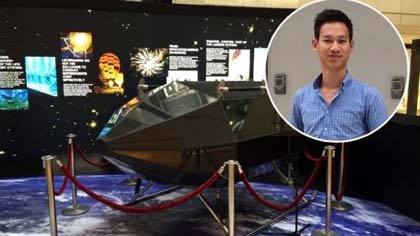Vietnam's first 'spacecraft' successfully launched
The first Vietnamese spacecraft made by a group of Vietnamese engineers was successfully launched into the space from the town of Alice Springs in Australia on May 16.
 |
| The spaceship model made by a Vietnamese engineering team on display in Singapore. Head of the team Pham Gia Vinh in the small picture. |
The event has attracted the attention of the domestic scientific community.
The device is a stratosphere flying machine and is currently operating stably at a height of 25km.
According to head of the manufacturing team Pham Gia Vinh, Vietnam’s first ‘spaceship’ has successfully approached near-space at an altitude of 25km. The device also acts as a simulated telecommunications satellite.
Vinh is the director of Dong Giang Vietnam Research & Development, one of the few companies making unmanned aircraft in Vietnam.
It took Vinh and his colleagues six months to make the device, which weighs 600kg and is capable of flying at a height of 30-50km and a maximum of one week.
After more than two years (from February 2014) of research and design with repeated testing, the launch has opened up positive prospects in the application of flying equipment to study the upper atmosphere, the environment, natural resources, telecommunications and national defence.
At an altitude of about 30km, the device will help scientists to easily observe and study the formation and paths of storms. The advantage of this device is that it can transfer data faster than satellites by sending live collected images.
In the field of information security, it can be used as a broadcast station for a week to serve repair in case a satellite is damaged. In addition, the flying instrument can operate as a radar system for national defence and scientific research.
It can bring along devices to observe and study cosmic rays and equipment for near-space environmental studies. The device is capable of testing satellite equipment (cameras and radars) before being integrated and put into space.
(Source: NDO)
 về đầu trang
về đầu trang







